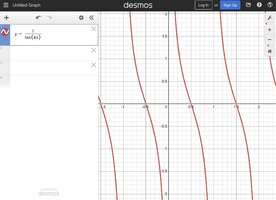Harry_the_cat
Elite Member
- Joined
- Mar 16, 2016
- Messages
- 3,693
What is the value of \(\displaystyle \frac{1}{\tan(\pi x)}\) when \(\displaystyle x = \frac{1}{2}\) ? Is it 0?
I know that \(\displaystyle \tan \theta = \frac{\sin \theta}{\cos \theta} \) tells us it is 0, but does that definition hold if \(\displaystyle \cos \theta =0\).
I know that \(\displaystyle \tan \theta = \frac{\sin \theta}{\cos \theta} \) tells us it is 0, but does that definition hold if \(\displaystyle \cos \theta =0\).


